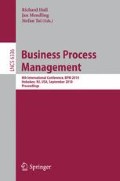Abstract
Substantial use of dedicated software characterizes the highest level of Business Process Management (BPM) maturity. Currently, companies are far below this level. This situation is due to the fact that the existing BPM tools don’t satisfy key requirements of BPM. We have conducted a worldwide survey of major public companies to elicit these requirements, which are grounded in the nature of processes and the usage of software. The analysis of 130 responses indicates that human-oriented process modeling languages and BPM tools as well as BPM tools with software integration capabilities are most urgently required.
Access this chapter
Tax calculation will be finalised at checkout
Purchases are for personal use only
Preview
Unable to display preview. Download preview PDF.
References
Economist Intelligence Unit (in co-operation with the IBM Institute for Business Value): The 2006 e-readiness rankings. A White Paper from the Economist Intelligence Unit. London et al. (2006)
Forbes: The Forbes Global (2000), http://www.forbes.com/2005/03/30/05f2000land.html
Gravetter, F.J., Wallnau, L.B.: Statistics for the Behavioral Sciences, 8th edn. Wadsworth, Belmont (2009)
Indulska, M., Recker, J., Rosemann, M., Green, P.: Business process modeling: Perceived Benefits. In: Laender, A.H.F. (ed.) ER 2009. LNCS, vol. 5829, pp. 458–471. Springer, Heidelberg (2009)
Indulska, M., Recker, J., Rosemann, M., Green, P.: Business process modeling: Current issues and future challenges. In: van Eck, P., Gordijn, J., Wieringa, R. (eds.) CAiSE 2009. LNCS, vol. 5565, pp. 501–514. Springer, Heidelberg (2009)
Jackson, S.L.: Research Methods and Statistics: A Critical Thinking Approach, 3rd edn. Wadsworth, Belmont (2009)
Jaklic, J., Bosilj-Vuksic, V., Stemberger, M.I.: Business Process Oriented Tool Selection Model – A Case Study. In: Hlupic, V., et al. (eds.) 1st Int. Conf. Future Challenges and Current Issues in Business Information, Organization and Process Management 2006, pp. 94–102. Westminster Business School, London (2006)
Künger, P., Hagen, C.: The fruits of Business Process Management: an experience report from a Swiss bank. Business Process Management Journal 13, 477–487 (2007)
Limesurvey, Version 1.85, http://www.limesurvey.org/
McCormack, K., et al.: A global investigation of key turning points in business process maturity. Business Process Management Journal 15, 792–815 (2009)
Neubauer, T.: An empirical study about the status of business process management. Business Process Management Journal 15, 166–183 (2009)
Nietro-Ariza, E.M., Rodriguez-Ortiz, G., Ortiz-Hermández, J.: An empirical evaluation for business process tools. In: Ochoa, S.F., Roman, G.-C. (eds.) Advanced Software Engineering: Expanding the Frontiers of Software Technology, pp. 77–84. Springer, Boston (2006)
Object Management Group (OMG): Business Process Model and Notation (BPMN), Version 1.2. OMG Document Number: formal/2009-01-03, http://www.omg.org/spec/BPMN/1.2/
Pernici, B., Weske, M.: Business process management. Data & Knowledge Engineering 56, 1–3 (2007)
Pritchard, J.-P., Armisted, C.: Business process management – Lessons from European Business. Business Process Management Journal 5, 10–35 (1999)
Rosemann, M., de Bruin, T., Hueffner, T.: A Model for Business Process Management Maturity. In: Proc. ACIS 2004, Paper 6 (2004), http://aisel.aisnet.org/acis2004/6
Recker, J.: BPMN Modeling – Who, where, how and why. BPTrends (March 2008) http://www.sparxsystems.com/press/articles/pdf/bpmn_survey.pdf
Schmietendorf, A.: Assessment of Business Process Modeling Tools under Consideration of Business Process Management Activities. In: Dumke, R., et al. (eds.) IWSM 2008. LNCS, vol. 5338, pp. 141–154. Springer, Heidelberg (2008)
van der Aalst, W.M.P., Benatallah, B., Casati, F., Curbera, F., Verbeek, E.: Business process management: Where business processes and web services meet. Data & Knowledge Engineering 61, 1–5 (2007)
Weske, M.: Business Process Management: Concepts, Languages, Architectures. Springer, Berlin (2007)
The Workflow Management Coalition (WfMC): The Workflow Reference Model, Document Number TC00-1003, Issue 1.1 (November 19 1995), http://www.wfmc.org/standards/docs/tc003v11.pdf
The Workflow Management Coalition (WfMC): Terminology & Glossary, Document Number WFMC-TC-1011, Issue 3.0 (February 1999), http://www.wfmc.org/standards/docs/TC-1011_term_glossary_v3.pdf
Wolf, C., Harmon, P.: The State of Business Process Management 2010. BPTrends Reports (February 2010), http://www.bptrends.com/surveys_landing.cfm
zur Muehlen, M., Recker, J., Indulska, M.: Sometimes less is more: Are process modeling languages overly complex? In: Proc. EDOC Conference Workshop, EDOC. Eleventh International IEEE, Annapolis, MD, pp. 197–204 (2007)
zur Muehlen, M., Recker, J.: How much language is enough? Theoretical and practical use of the Business Process Modeling Notation. In: Bellahsène, Z., Léonard, M. (eds.) CAiSE 2008. LNCS, vol. 5074, pp. 465–479. Springer, Heidelberg (2008)
Author information
Authors and Affiliations
Editor information
Editors and Affiliations
Rights and permissions
Copyright information
© 2010 Springer-Verlag Berlin Heidelberg
About this paper
Cite this paper
Patig, S., Casanova-Brito, V., Vögeli, B. (2010). IT Requirements of Business Process Management in Practice – An Empirical Study . In: Hull, R., Mendling, J., Tai, S. (eds) Business Process Management. BPM 2010. Lecture Notes in Computer Science, vol 6336. Springer, Berlin, Heidelberg. https://doi.org/10.1007/978-3-642-15618-2_4
Download citation
DOI: https://doi.org/10.1007/978-3-642-15618-2_4
Publisher Name: Springer, Berlin, Heidelberg
Print ISBN: 978-3-642-15617-5
Online ISBN: 978-3-642-15618-2
eBook Packages: Computer ScienceComputer Science (R0)

